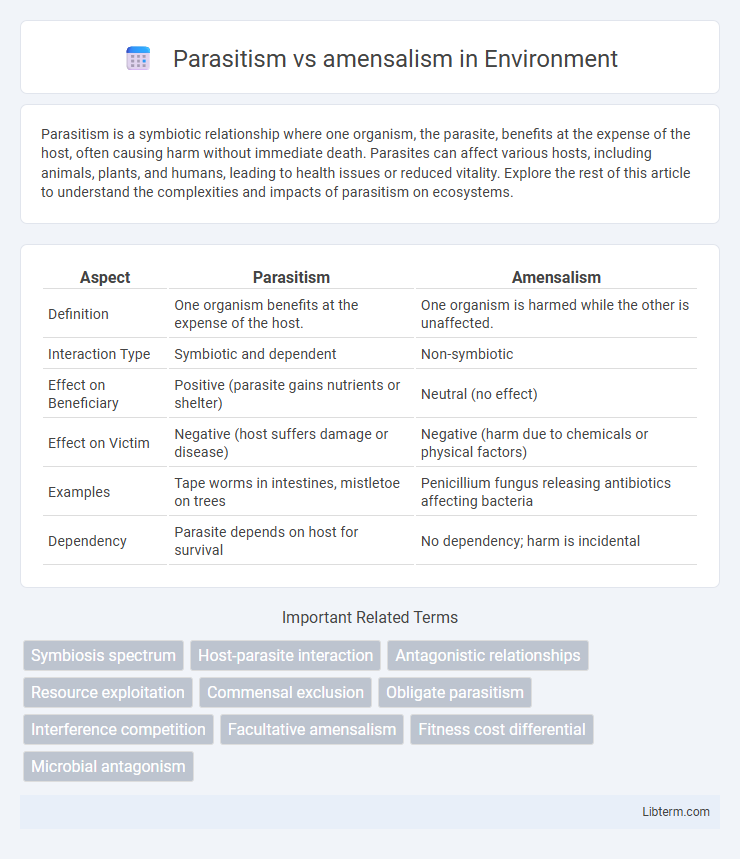Parasitism is a symbiotic relationship where one organism, the parasite, benefits at the expense of the host, often causing harm without immediate death. Parasites can affect various hosts, including animals, plants, and humans, leading to health issues or reduced vitality. Explore the rest of this article to understand the complexities and impacts of parasitism on ecosystems.
Table of Comparison
| Aspect | Parasitism | Amensalism |
|---|---|---|
| Definition | One organism benefits at the expense of the host. | One organism is harmed while the other is unaffected. |
| Interaction Type | Symbiotic and dependent | Non-symbiotic |
| Effect on Beneficiary | Positive (parasite gains nutrients or shelter) | Neutral (no effect) |
| Effect on Victim | Negative (host suffers damage or disease) | Negative (harm due to chemicals or physical factors) |
| Examples | Tape worms in intestines, mistletoe on trees | Penicillium fungus releasing antibiotics affecting bacteria |
| Dependency | Parasite depends on host for survival | No dependency; harm is incidental |
Introduction to Parasitism and Amensalism
Parasitism is a biological interaction where one organism, the parasite, benefits at the expense of the host, often causing harm but not immediate death. Amensalism describes a relationship where one species is inhibited or destroyed while the other remains unaffected, typically seen in the secretion of antibiotics by fungi that suppress bacteria. These ecological interactions play crucial roles in shaping community dynamics and influencing species survival.
Defining Parasitism: Key Characteristics
Parasitism is a biological interaction where one organism, the parasite, benefits at the expense of the host, often causing harm but not immediate death. Key characteristics include the parasite's dependency on the host for nutrients and shelter, specialized adaptations for attachment and feeding, and a life cycle closely linked to the host's biology. Unlike amensalism, where one species is inhibited or destroyed without benefit to the other, parasitism involves a clear exploitation dynamic with measurable fitness costs to the host.
Understanding Amensalism: Core Features
Amensalism is an ecological interaction where one organism is inhibited or destroyed while the other remains unaffected, differing from parasitism where the parasite benefits at the host's expense. Core features of amensalism include the suppression of one species through chemical secretions, physical obstruction, or competition without reciprocal effects on the inhibiting species. Examples include the release of antibiotics by fungi that inhibit bacterial growth and the shading effects of large plants that limit sunlight for smaller plants beneath them.
Fundamental Differences Between Parasitism and Amensalism
Parasitism involves one organism benefiting at the expense of another, typically through direct interaction where the parasite derives nutrients or resources from the host, often causing harm. Amensalism describes a relationship where one organism is inhibited or destroyed while the other remains unaffected, usually through the release of harmful substances rather than direct contact. The fundamental difference lies in the interaction dynamics: parasitism requires a dependent relationship causing harm to the host, whereas amensalism reflects incidental harm without any benefit or dependency for the unaffected organism.
Ecological Roles of Parasitism
Parasitism plays a critical ecological role by regulating host population dynamics, often reducing host fitness without immediate lethality, which helps maintain species diversity and ecosystem stability. Parasites influence energy flow by extracting nutrients from hosts, thereby impacting food web interactions and nutrient cycling. Their presence can drive evolutionary pressures, promoting adaptations in both host and parasite species that shape community structure and ecosystem resilience.
Ecological Roles of Amensalism
Amensalism plays a crucial ecological role by influencing population dynamics without direct benefit or harm to the amensal species, often involving the release of inhibitory substances like antibiotics by fungi or plants that suppress nearby organisms. This process helps maintain species diversity and ecosystem balance by controlling dominant species' overgrowth and preventing competitive exclusion. Unlike parasitism, where one organism benefits at the expense of the host, amensalism primarily exhibits unidirectional harm, shaping community structure through subtle chemical or physical interactions.
Examples of Parasitism in Nature
Parasitism is a biological interaction where one organism, the parasite, benefits at the expense of the host, causing harm without immediate death. Common examples include the relationship between tapeworms and mammals, where the tapeworm absorbs nutrients from the host's intestines, and the parasitic wasp laying eggs inside caterpillars, leading to the host's eventual death. Unlike amensalism, where one organism is inhibited or destroyed while the other remains unaffected, parasitism directly exploits and harms the host for survival.
Examples of Amensalism in Nature
Amensalism in nature is exemplified by black walnut trees (Juglans nigra) releasing juglone, a chemical that inhibits the growth of nearby plants, negatively affecting their survival without deriving any benefit. Another instance includes Penicillium mold secreting penicillin, which kills or suppresses the growth of susceptible bacteria in its vicinity. These interactions contrast with parasitism, where one organism benefits at the expense of the host, while in amensalism, one organism is harmed and the other remains unaffected.
Impacts on Biodiversity and Ecosystems
Parasitism affects biodiversity by directly reducing host populations and altering community dynamics through the extraction of resources, often leading to changes in species abundance and interactions. Amensalism impacts ecosystems by inhibiting or killing certain species without benefit to the other organism, which can decrease species diversity and disrupt ecological balance. Both interactions influence ecosystem stability, but parasitism tends to drive coevolutionary adaptations, whereas amensalism results in asymmetric suppression that may simplify community structure.
Parasitism vs. Amensalism: Summary and Conclusion
Parasitism involves one organism benefiting at the expense of another, often causing harm or disease to the host, whereas amensalism describes a relationship where one species is inhibited or destroyed while the other remains unaffected. Parasitism plays a critical role in ecosystem dynamics by influencing host population and health, while amensalism typically results from the production of antibiotics or chemical substances that inhibit competitors. Understanding the distinctions aids in ecological management and biological control strategies by highlighting the direct impact parasitism has on host species compared to the indirect, often chemically mediated effects seen in amensalism.
Parasitism Infographic

 libterm.com
libterm.com